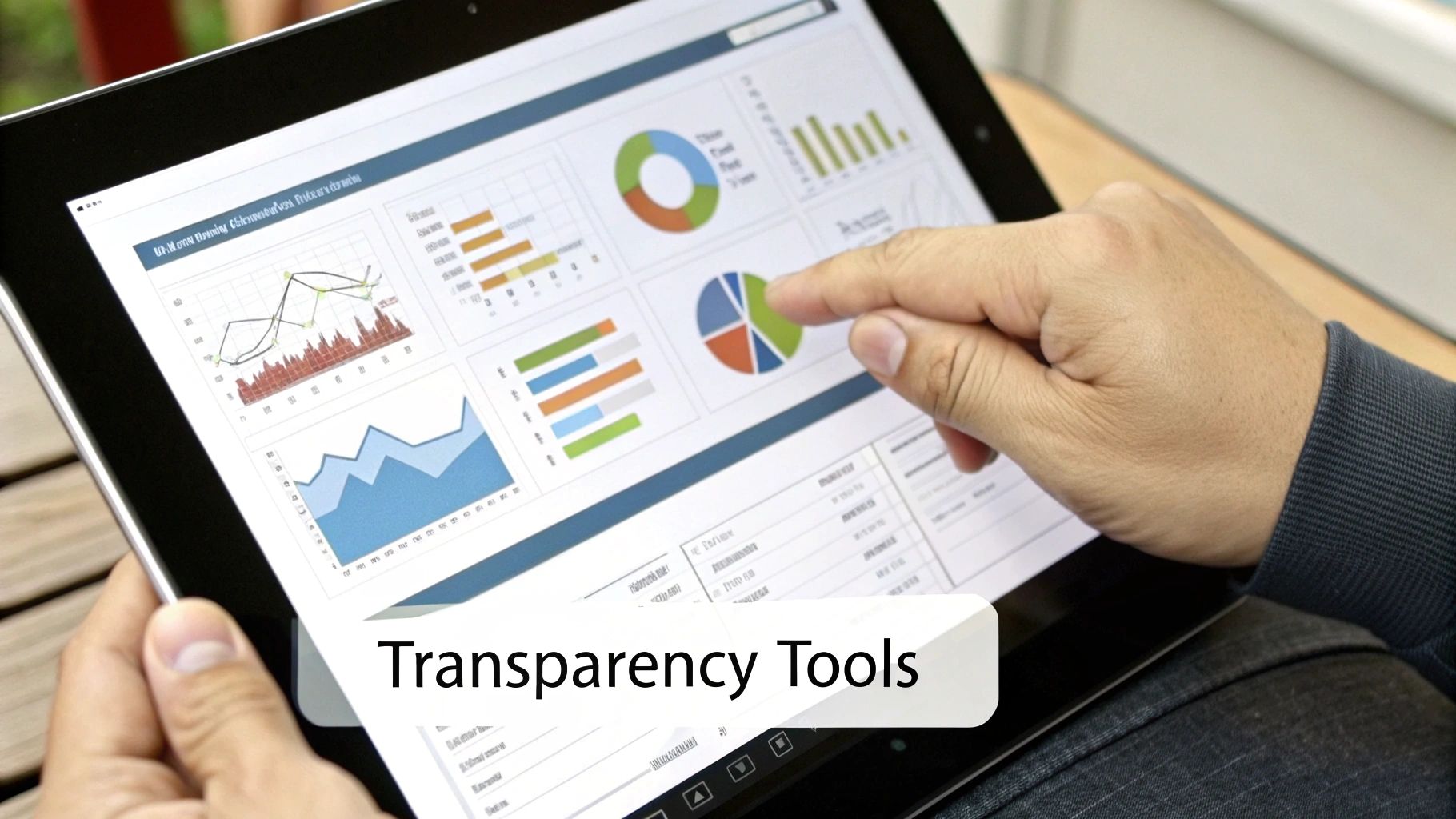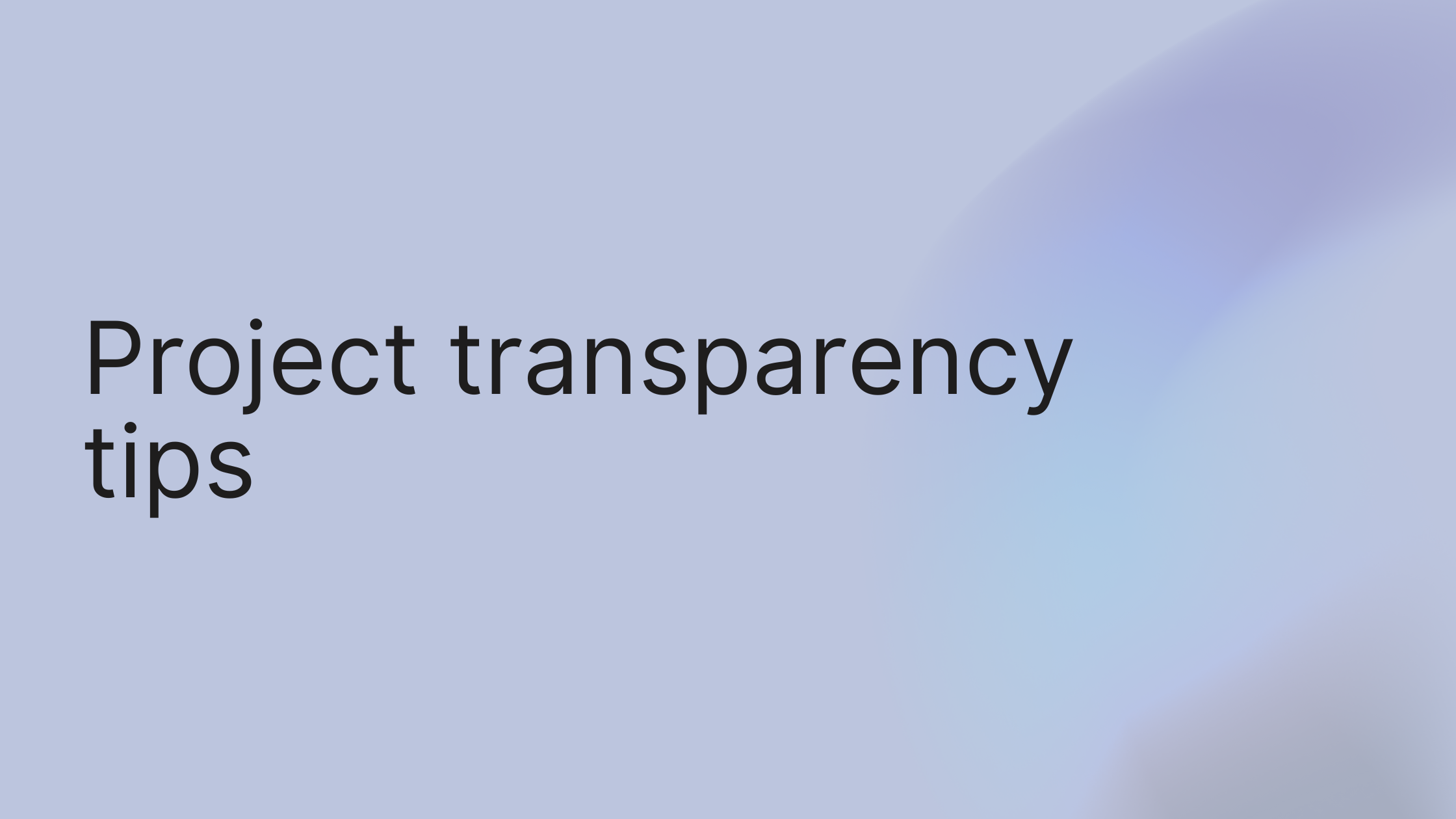Ever had that sinking feeling when a project you thought was on track suddenly goes off the rails? You’re not alone. It’s the classic sign of a project operating in a "black box," where no one has a clear view of what’s actually happening. Here’s a quick win to fix it: create a single, shared dashboard for your project. This one move replaces guesswork with clarity and is the first step toward genuine project transparency.
Think of project transparency as opening up the lines of communication. It’s the practice of making all project information—from high-level goals and specific tasks to real-time progress and emerging challenges—openly and easily accessible to everyone involved. This simple but powerful shift from secrecy to clarity prevents nasty surprises and builds a culture of trust.
Why Do Your Projects Feel Like a Black Box?
Does this situation ring a bell? You're leading a project, and on the surface, everything looks great. Your team members all say they’re "on it," and the early check-ins are all thumbs-up. Then, with a major deadline just days away, you uncover a disaster: a critical dependency was completely overlooked, a key task was misinterpreted, and now the entire timeline is in jeopardy.
This is what happens when a project becomes a "black box." You know what you put in (the resources) and you know what you want to get out (the deliverable), but everything that happens in between is a total mystery. Managing a project without transparency is like trying to drive through a dense fog. You might know your destination, but you can’t see the road five feet in front of you, forcing you to crawl along and dramatically increasing the risk of a crash.
The Source of the Fog
This lack of visibility doesn't just happen. It's usually caused by a few common problems that quietly build up over time.
- Information Silos: Critical updates and decisions are buried in scattered email chains, private Slack messages, or worse, on individual hard drives. There's no single source of truth.
- Fuzzy Priorities: Team members might be working incredibly hard, but on the wrong things. Without a shared, crystal-clear view of the project's main objectives, their effort is often misaligned.
- Delayed Bad News: People naturally hesitate to report small problems. But when communication is closed off, those minor hiccups fester in the dark until they explode into full-blown crises.
One of the biggest culprits behind the "black box" effect is simple document chaos. When no one can find what they need, transparency is impossible. You can start clearing the fog by mastering proven strategies to organize business documents and creating a system everyone can rely on.
Mini-Case Study: How "PixelPerfect" Agency Gained Clarity
A small marketing agency, let's call them "PixelPerfect," was stuck in a frustrating cycle of endless revisions and unhappy clients. Their designers, writers, and strategists were all talented, but they worked in completely separate bubbles, leading to constant rework.
Their breakthrough wasn't a complex new methodology. It was a simple, powerful change: they created a unified project dashboard in a shared workspace.
Instantly, everyone—including the client—was looking at the same task list, the same deadlines, and the same real-time progress updates. The guesswork vanished.
The result? A stunning 40% reduction in rework within the first quarter. By replacing the fog of assumptions with the simple clarity of a shared screen, they stopped wasting time and started delivering great work, faster.
This one move—creating a single source of truth—is often the quickest way to introduce meaningful project transparency into your own workflow.
The Pillars of Real Project Transparency

True project transparency isn’t just about sharing everything all the time. It’s a deliberate strategy built on three core pillars. When these elements are in place and working together, they create a powerful culture of trust, alignment, and efficiency that completely changes how work gets done.
Pillar 1: Clear Goals
Everything flows from a shared understanding of "why." If your team doesn't know what the finish line looks like, they're just running in the dark.
Action Step: Write down your top three project goals in simple, measurable terms. Pin this list to the top of your project's main communication channel or dashboard where no one can miss it. This ensures every task, no matter how small, points toward the larger objective.
Pillar 2: Open Communication
Once you’ve set the goals, the next step is making sure information flows freely and centrally. Transparency dies when important conversations get scattered across private messages, emails, and random DMs.
Action Step: Create a dedicated channel or space for each project in a tool like growlio. Mandate that all project-related discussions and decisions happen there. This stops vital information from getting lost and creates a searchable, single source of truth. A great habit to build here is creating effective meeting summaries and posting them in the project channel.
Pillar 3: Accessible Data
The final pillar is where your goals and communication become tangible. It’s about making real-time information on progress available to everyone who needs it.
Action Step: Use a shared Kanban board or task list where every task has a clear owner, due date, and status (e.g., To-Do, In Progress, In Review). This allows anyone, from team members to stakeholders, to see project health at a glance without scheduling a status meeting.
Pro Tip: In your growlio workspace, you can easily implement all three pillars. Use a project's "Overview" tab to post goals, the "Chat" tab for open communication, and the "Tasks" tab for accessible data. This keeps everything organized in one predictable place.
These three pillars—clear goals, open communication, and accessible data—work in concert to break open the "black box" of project management. When everyone can see the plan, the progress, and the purpose, amazing things happen.
The Undeniable Benefits of An Open Workflow

Embracing an open workflow is more than just an organizational tweak; it’s a strategic move that pays real dividends. Beyond just feeling more organized, project transparency delivers tangible results that improve team performance and, ultimately, your bottom line. It’s how you shift from a culture of confusion to one of shared purpose.
Boosting Morale and Accountability
When everyone can see who is responsible for what, accountability just clicks into place. It’s no longer a mystery who owns a task or when it’s due, which eliminates the ambiguity that often leads to finger-pointing. This isn't about micromanaging people; it's about empowering them with the information they need to succeed.
This clarity has a direct, positive impact on morale. Teams with transparent processes consistently report higher job satisfaction because they waste less time on frustrating rework and feel a much stronger sense of collective ownership. They aren't just cogs in a machine; they're active participants in a process they can see, understand, and influence. This becomes especially critical as you learn to master project management for multiple projects, where transparency is the key to juggling competing priorities without dropping the ball.
A Real-World Case of Transparency Driving Impact
The power of an open workflow isn't just for corporate offices—it operates on a global scale. A great example is the International Aid Transparency Initiative (IATI), which allows for real-time tracking of development funds.
This initiative helped Nigeria map roughly $5 billion in activities directly to its national development plan, which dramatically improved how resources were used. This level of project transparency helped tackle huge funding gaps for global goals and showcased how visibility leads to better outcomes.
Connecting Transparency to the Bottom Line
At the end of the day, an open workflow is good for business. It directly impacts your financial health in a few key ways.
- Smarter Resource Allocation: You can see exactly where your team’s time and effort are going, allowing you to shift resources toward the most impactful work.
- Faster Project Delivery: With fewer bottlenecks and less back-and-forth, projects move from start to finish much more quickly.
- Higher Client Retention: Clients love visibility. When they can see progress for themselves, they trust you more and are far more likely to come back for future projects.
Your Step-By-Step Guide to Project Transparency
Bringing transparency from a buzzword into your daily reality isn't about some massive, disruptive overhaul. It's about taking a series of deliberate, practical steps that fundamentally change how your team talks, works, and gets things done.
Step 1: Centralize Your Workspace
First, you must kill the information silos. Project details scattered across forgotten email threads, private DMs, and individual hard drives are a recipe for chaos.
Action: Choose a central hub, like growlio, where all project-related conversations, files, and tasks will live. This isn't just about getting organized; it's about making information discoverable. It ends the frustrating scavenger hunt for the latest file version or that one critical decision someone made last Tuesday. A key part of this is mastering process documentation best practices to ensure your workflows are clear and consistent.
Step 2: Define and Share Clear Project Goals
With everything in one place, the next job is to make sure everyone understands the "why." Vague goals lead to wasted effort.
Action: Define your project's main objectives in simple, measurable terms. Write them down and pin them somewhere impossible to miss in your shared workspace, like the top of a project channel.

Step 3: Standardize How You Manage Tasks
Once goals are clear, it’s time to manage the work. A standardized approach to task management is your best defense against things falling through the cracks.
Action: For every task, assign a clear owner, a specific due date, and a current status (e.g., To-Do, In Progress, or Done). Using a visual task board in your central hub makes this information instantly accessible to everyone. The screenshot below shows a simple yet effective task view in growlio.
Step 4: Automate Your Reporting to Stakeholders
The final step is making progress visible to clients and leadership without tedious manual work. Nobody enjoys compiling weekly status reports.
Action: Use your central platform to automate reporting. Modern tools like growlio can create dashboards that pull live data on task completion, budget burn, and timeline progress. This gives stakeholders self-serve access to the information they care about, building immense trust and freeing up your team from admin work.
How a Marketing Agency Cut Rework by 40 Percent
How many times have you heard, "Just one more small change"? If you work at a marketing agency, that request can derail a week's work. The endless cycle of revisions and scope creep eats away at profits and team sanity.
Let’s look at a fictional creative agency, "PixelPerfect." They were constantly fighting missed deadlines and ballooning budgets because clients were completely in the dark until the final deliverable. This led to surprise feedback and costly rework. The team knew they had to improve their project transparency to survive.
The Shift to a Shared Reality
PixelPerfect's transformation came from three practical changes, all powered by a central hub like growlio.
- A Client-Facing Dashboard: They replaced scattered email updates with a single, shared dashboard where clients could log in anytime and see the real-time status of every task.
- Shared Task Lists with Clear Owners: Every deliverable was broken down into individual tasks assigned to a specific team member, eliminating the “I thought you were handling that” confusion.
- Automated Weekly Progress Reports: They set up an automated summary report, ensuring clients received consistent communication without adding more administrative work for the team.
This kind of openness isn't just a project management tactic; it reflects a much bigger business trend. Look at the Carbon Disclosure Project (CDP), which scores thousands of global companies on their environmental reporting. This transparency drives real results: companies that are open about their environmental impact achieve an average reduction in carbon emissions of 7-10%. You can dig into the full findings from the CDP to see how this works on a global scale.
Pro Tip: Advanced Stakeholder Views
Worried about showing clients too much? Smart platforms let you control what people see. With a tool like growlio that has role-based permissions, you can create a simplified "Client View" of a project. This hides internal team chatter and nitty-gritty sub-tasks, giving stakeholders the clarity they need without overwhelming them with unnecessary detail.
The results for PixelPerfect were dramatic. Within six months, they saw a 40% reduction in rework and a 25% boost in on-time project delivery. By making their process visible, they built incredible trust and turned their clients into partners.
Ready to Bring Real Clarity to Your Projects?
We’ve walked through what happens when projects are stuck in the dark and, more importantly, how to bring them into the light. Building a culture of project transparency isn't about creating more rules. It’s about giving your team the information and confidence they need to do their best work.
The same principles that foster trust with clients are just as powerful for your internal teams. It’s a core part of what we cover in our guide to client onboarding best practices. When you make your workflows visible, you're not just organizing tasks; you're building a foundation of accountability and replacing guesswork with genuine confidence.
Now it's time to take the next step. Your journey toward total project clarity begins with having the right tools.
Take the first step today. Start a free growlio account and build your first transparent project in minutes. Give your team the clarity they need to deliver exceptional results.
Frequently Asked Questions About Project Transparency

Does the thought of making every project detail visible feel like you’re just opening the door to micromanagement? That’s a common concern, but in practice, the opposite is usually true. The trick is to reframe your thinking: view project transparency not as a tool for constant supervision, but as a foundation for empowerment.
When information flows freely, you naturally cultivate a culture of trust and autonomy. Team members don't need to wait for instructions or check in constantly; they can see the bigger picture for themselves and make smarter, more informed decisions on the fly.
How Do I Get Buy-In from My Team?
Trying to force transparency as another top-down rule is almost guaranteed to meet resistance. A much better approach is to present it as the answer to common, everyday frustrations. Start a conversation with your team. Ask them: What are your biggest time sinks? Are you tired of digging through old emails for files, waiting forever on approvals, or trying to figure out who’s responsible for a task?
Once you identify those pain points, you can show them exactly how a more transparent system solves them. For example, a central hub with clear task ownership means less time wasted asking, "Hey, who's got this?" and more time actually getting meaningful work done. This helps your team see transparency as a tool that genuinely helps them, not just another reporting burden for management.
What Are the Most Important Metrics to Track?
You could easily get lost tracking dozens of different data points, but the key is to focus on the vital few that truly reflect your project's health. If you’re just starting out, concentrate on these three:
- Task Completion Rate: This tells you if you're maintaining momentum and hitting your deadlines.
- Budget Variance: A simple measure to see if you're staying on track financially or if costs are starting to creep up.
- Team Workload: This is crucial for spotting potential burnout before it tanks productivity and morale.
A platform like growlio can automatically track these metrics and display them on a simple, easy-to-read dashboard. You get an instant snapshot of project health without ever touching a spreadsheet.
This frees you and your team up to focus on solving problems and making strategic moves instead of just managing data.
Ready to build a culture of clarity and high performance? growlio gives you all the tools you need—from shared task boards to automated reports—to make project transparency your team's new reality. Start your free growlio account today and see the difference for yourself.
